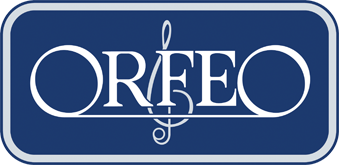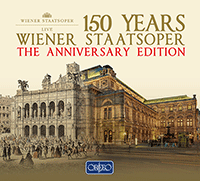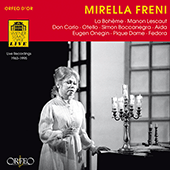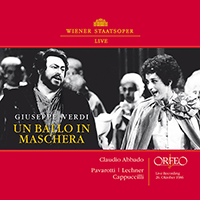Luciano Pavarotti
Pavarotti’s father was a baker and an amateur tenor and his mother worked in a cigar factory, alongside Mirella Freni’s mother; the family had little money. As a youth he listened to his father’s records of popular tenors and admired the films of Mario Lanza. After completing his formal schooling (and abandoning the idea of becoming a football goalkeeper) he taught in an elementary school for two years and only began to study singing seriously when he was nineteen, with the tenor Arrigo Pola in Modena, who taught him without fee.
Together with his father, Pavarotti was a member of a male-voice choir which won first prize at the Welsh International Eisteddfod in 1955. This inspired him to become a professional singer and after Pola moved to Japan, he studied with Ettore Campogalliani (who also taught his childhood friend Mirella Freni) while continuing to work, including a stint as an insurance salesman. He made his operatic stage debut in 1961 at Reggio Emilia as Rodolfo / La Bohème.
After singing in Italy, Pavarotti made his debut at the Vienna State Opera in 1963 as Alfredo / La traviata, shortly afterwards also singing Rodolfo and the Duke / Rigoletto there. In the same year he substituted for one of his childhood heroes, Giuseppe di Stefano, as Rodolfo at the Royal Opera House, Covent Garden and in 1964 sang Idamante / Idomeneo at the Glyndebourne Festival. Pavarotti returned to Covent Garden frequently, as Tonio / La Fille du Régiment, Alfredo, the Duke and Edgardo / Lucia di Lammermoor; his success and popularity there led to an influential recording contract with Decca, who also recorded Joan Sutherland.
He made his American debut in 1965 at Miami as Edgardo, singing opposite Joan Sutherland, who engaged him to accompany her on a large-scale opera tour of Australia during the same year. This followed a successful debut at La Scala, Milan singing Rodolfo opposite Freni with Karajan conducting. As he did with other opera houses, Pavarotti was to return often to La Scala, notably as Tebaldo / I Capuleti e i Montecchi under Abbado. He sang Arturo / I puritani at Catania in 1968 and frequently appeared at the Verona Arena: in 1971–1973, 1976, 1978, 1980 and 1985. At the San Francisco Opera he first appeared in 1967 as Rodolfo, becoming a great local favourite and returning as, for instance, Rodolfo / Luisa Miller, Enzo / La Gioconda and Calaf / Turandot. His Salzburg Festival debut was in recital, in 1976; he returned as the Italian Singer / Der Rosenkavalier in 1978 and in the title role of Idomeneo in 1983.
Pavarotti first sang at the Metropolitan Opera, New York in 1968, again as Puccini’s Rodolfo. He appeared there regularly until his farewell appearance in 2004, in a large repertoire that included Nemorino / L’elisir d’amore, Riccardo / Un ballo in maschera, Cavaradossi / Tosca and the title roles of Ernani, Idomeneo and Andrea Chénier. Having sung Rodolfo in the first ‘Live from the Met’ television broadcast in 1977, he immediately realised the vast potential audience for opera and during the late 1970s began to give concerts in large auditoria.
These performances were to become a key element in his schedule, taking him to many varied locations across the world. Their success reached a peak in 1990 when the first ‘Three Tenors’ concert took place. This was in Rome, coinciding with the football World Cup, for the broadcasts of which Pavarotti’s thrilling singing of ‘Nessun dorma’ from Turandot was the theme tune. The international fervour aroused by these two events caused Pavarotti’s international popularity to reach extraordinary heights.
In the opera house meanwhile, his appearances began to dwindle, but not before he had essayed the title role in Verdi’s Otello: in concert, with Solti conducting, in Chicago and New York in 1991. Other performances of note included La Bohème under Carlos Kleiber in Vienna and Radamès / Aida with Maazel at La Scala (both 1985). On the popular front Pavarotti attracted huge audiences for his open-air concerts. These included the famous Hyde Park concert in London, which attracted an audience of 150,000; and a free concert in New York’s Central Park, with both a world-wide television audience as well as an actual audience of half a million. In 1998 he received a Grammy Legend Award, truly reflecting his extraordinary international appeal.
Exceptional as Pavarotti’s voice was, with its rich and generous tone, it was perhaps his easy-going and genial personality that communicated itself effortlessly throughout the world to ‘the man in the street’. For many he was the epitome of the Italian tenor: able to give memorable accounts of the core Italian repertoire, even if his stage presence tended to the static; but also, as with his great forebears such as Caruso, to turn his hand to popular songs without condescension. His global popularity was reflected in and stimulated by his huge formal and informal discography and videography. Singers such as Pavarotti appear but rarely.
© Naxos Rights International Ltd. — David Patmore (A–Z of Singers, Naxos 8.558097-100).



















